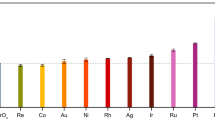Abstract
THE first report of isotopic exchange in a solid system was given by Kaucic and Vlatkovic1. They heated Ca(IO3)2 doped with 131I− at temperatures higher than 170° C and observed, by chemical analysis, incorporation of activity into the iodate. Apers et al.2 found that thermal treatment of K2CrO4 doped with 51Cr3+ results in the incorporation of chromium-51 activity into the chromate form. This overall process, which results in the incorporation of radio-species having a non-parent oxidation state into the parent chemical form, has been termed “transfer annealing”2—a process which may involve either an oxidation or a reduction of the tracer species and is not necessarily an isotopic exchange. In a subsequent article3, the same group of researchers considered several possible mechanisms for oxidation of the dopant 51O3+, resulting in the formation of species (in the solid state) which would form the parent chromate during subsequent dissolution. Incorporation of activity into the chromate by isotopic exchange was not considered. Later, Nath et al.4–6 showed that isotopic exchange exists in complex molecules; in this case, cobalt chelates doped with radio-Co2+. They considered that it was not possible to interpret the incorporation of cobalt activity in the chelate form by the oxidative mechanisms suggested for the K2CrO4–51Cr3+ system2,3, and they regarded “transfer annealing” as a genuine case of isotopic exchange. In some systems, for example tris-dipyridy Co(III) perchlorate trihydrate doped with 57Co++, the exchang occurs quite rapidly even at room temperatures. Nath et al. have suggested that the energy required to overcome the large potential barriers encountered in isotopic exchange in the solid state is derived from electrons detrapped from donors during thermal treatment. A free electron is captured by 57Co++ ion to form a highly excited 57Co+ ion which, in turn, interacts with a neighbouring chelate molecule and replaces the inactive cobalt atom.  where *Co+ represents the highly excited ion.
where *Co+ represents the highly excited ion.
This is a preview of subscription content, access via your institution
Access options
Subscribe to this journal
Receive 51 print issues and online access
$199.00 per year
only $3.90 per issue
Buy this article
- Purchase on Springer Link
- Instant access to full article PDF
Prices may be subject to local taxes which are calculated during checkout
Similar content being viewed by others
References
Kaucic, S., and Vlatkovic, M., Croat. Chem. Acta, 35, 305 (1963).
Apers, D. J., Collins, K. E., Collins, C. H., Ghoos, Y. F., and Capron, P. C., Radiochim. Acta, 3, 18 (1964).
Collins, C. H., Collins, K. E., Ghoos, Y. F., and Apers, D. J., Radiochim. Acta, 4, 211 (1965).
Nath, A., Khorana, S., Mathur, P. K., and Sarup, S., Indian J. Chem., 4, 51 (1966).
Nath, A., and Khorana, S., J. Chem. Phys., 46, 2858 (1967).
Khorana, S., and Nath, A., J. Phys. Chem. Solids, 28, 1081 (1967).
Gainar, I., Revue Roumaine de Physique, 11, 539 (1966).
Boyd, G. E., and Larson, Q. V., J. Amer. Chem. Soc., 90, 254 (1968).
Andersen, T., Langvad, T., and Sørensen, G., Nature, 218, 1158 (1968).
Nath, A., Klein, M. P., Kündig, W., and Lichtenstein, D., Proceedings of the Fifth Mössbauer Meeting (New York, 1969).
Nath, A., and Vaish, S. P., J. Chem. Phys., 46, 4660 (1967).
Author information
Authors and Affiliations
Rights and permissions
About this article
Cite this article
NATH, A., KLEIN, M. Direct Observation of Isotopic Exchange in the Solid State. Nature 224, 794–795 (1969). https://doi.org/10.1038/224794a0
Received:
Issue Date:
DOI: https://doi.org/10.1038/224794a0
Comments
By submitting a comment you agree to abide by our Terms and Community Guidelines. If you find something abusive or that does not comply with our terms or guidelines please flag it as inappropriate.



